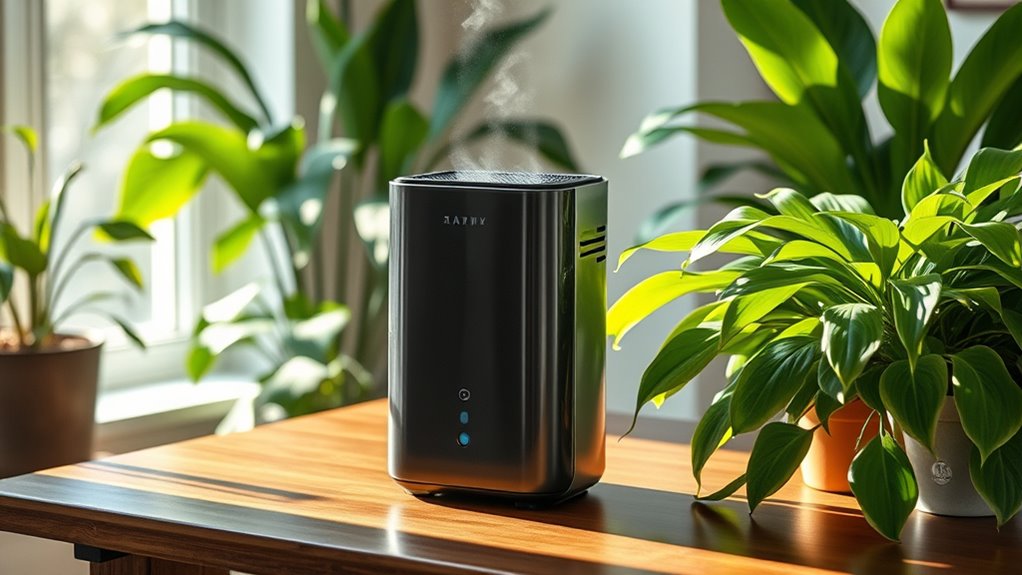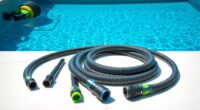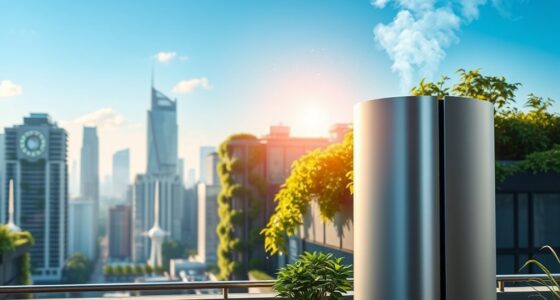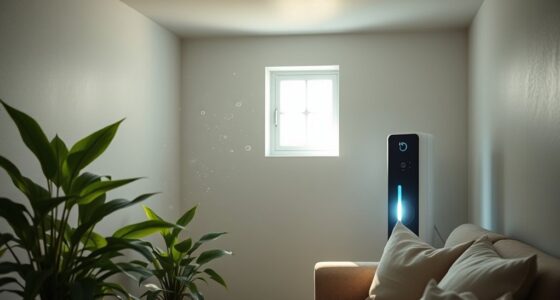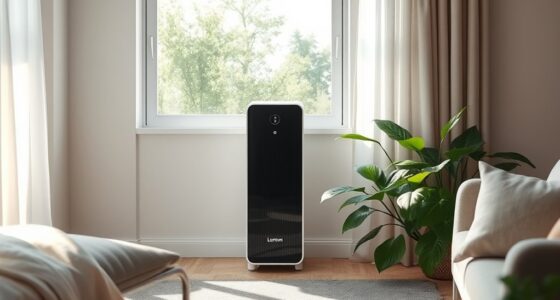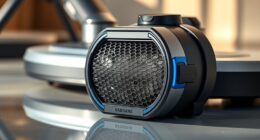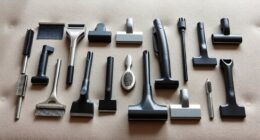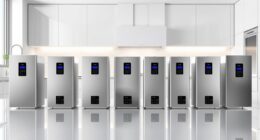Air purifiers are essential for improving indoor air quality and alleviating respiratory issues. Did you know that indoor pollution can be worse than outdoor air? HEPA filters capture 99.97% of allergens, making them a must-have for allergy sufferers. Not all purifiers are created equal, though; features like CADR and maintenance play a crucial role in their effectiveness. If you’re curious about which type suits your needs best and how to maintain them, keep exploring!
Key Takeaways
- Air purifiers with HEPA filters can capture up to 99.97% of allergens and particles as small as 0.3 microns, significantly improving indoor air quality.
- Regular filter maintenance is essential, as clogged filters reduce airflow and diminish the effectiveness of pollutant removal, impacting health.
- Clean Air Delivery Rate (CADR) should be at least two-thirds of the room size for optimal air purification efficiency.
- Not all air purifiers are created equal; technology, efficiency, and features vary widely among models, affecting their performance.
- Ozone generators are not recommended, as they produce lung irritants, contrary to their intended purpose of cleaning the air.
Understanding Air Quality and Its Impact on Health
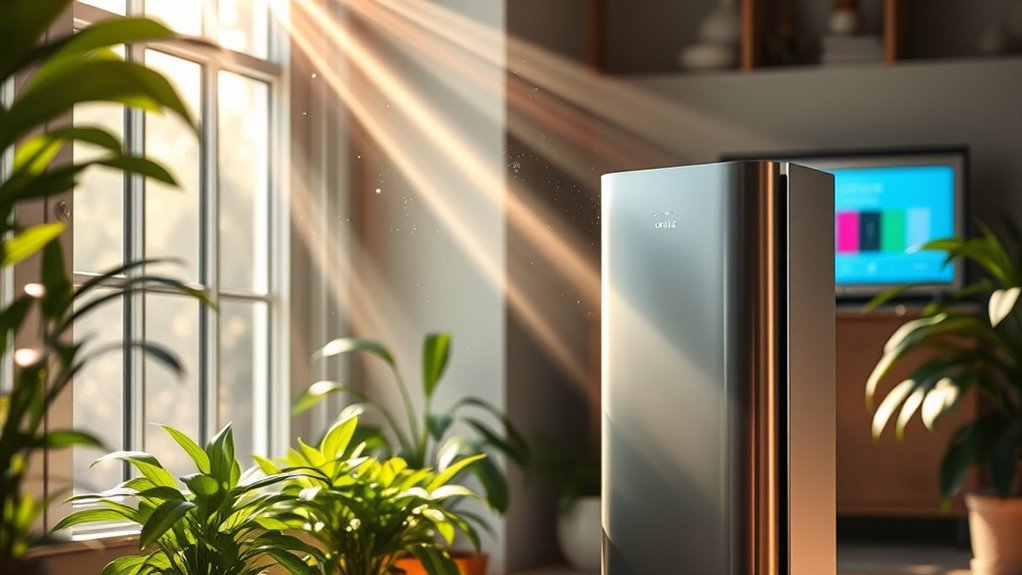
When you breathe, the quality of the air around you directly affects your health. Poor air quality, particularly indoors, can lead to serious respiratory issues.
Did you know that indoor air pollution can be 2-5 times worse than outdoor air? Dust, mold, and chemicals from household products contribute to this problem, increasing your exposure to harmful pollutants. Additionally, the use of air purifiers with HEPA filters can significantly mitigate these pollutants and improve indoor air quality. Regular use of air purifiers can lead to improved respiratory health and alleviate symptoms of asthma and allergies. Consistent maintenance, such as regular cleaning, is essential for optimal performance of these devices. Moreover, smart technology in modern air purifiers allows for automatic operation based on air quality detection.
If you suffer from allergies, airborne allergens like pollen and pet dander can trigger symptoms such as hives and difficulty breathing. With over 100 million Americans facing allergies annually, managing your indoor air quality is essential.
Using air purifiers can help reduce airborne allergens and pollutants, ultimately improving your overall health and comfort in your living space. Additionally, employing HEPA filters in air purifiers can significantly enhance the removal of tiny particles, ensuring cleaner air.
How Air Purifiers Function: The Science Behind the Clean
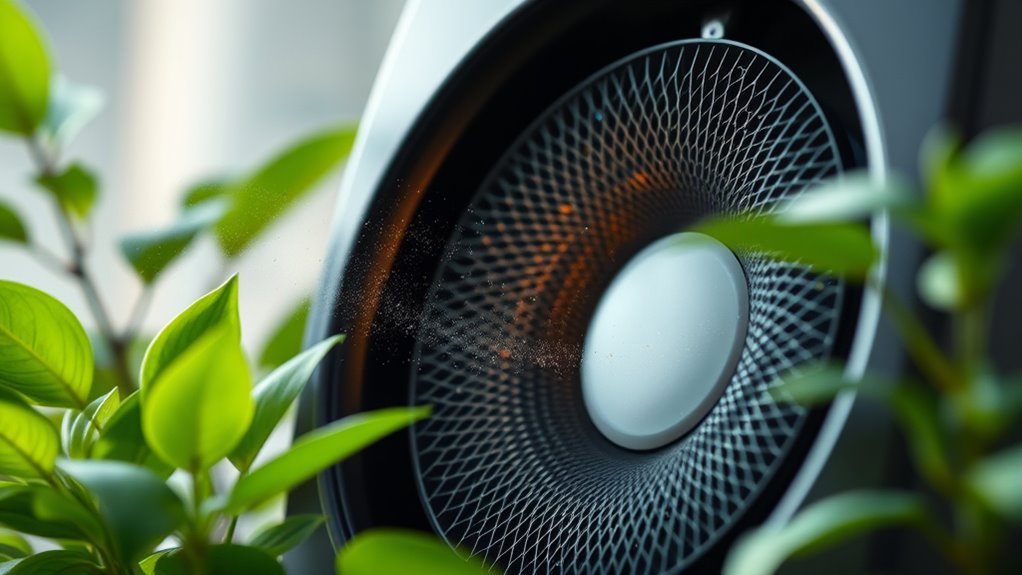
Air purifiers use advanced filtration mechanisms to improve your indoor air quality. By drawing air through filters, they capture dust, pollen, and other harmful particles, making the air you breathe cleaner. Regularly checking and cleaning filters is essential for maintaining optimal air quality in your space. Understanding how airflow and efficiency play a role in this process can help you choose the best air purifier for your needs. Additionally, many air purifiers utilize HEPA filter technology to effectively remove allergens and pollutants from the air. Incorporating sound therapy can further enhance your environment by promoting relaxation and reducing stress related to air quality concerns. Many models also feature smart technology that allows for remote control and scheduling, making them even more convenient to use. Investing in an air purifier can be comparable to the costs associated with a home security system, ensuring both safety and health in your living space.
Filtration Mechanisms Explained
Understanding how air purifiers work is essential for improving your indoor air quality. These devices employ various filtration mechanisms, primarily HEPA filters, which capture up to 99.97% of particulate matter as small as 0.3 microns, including allergens and viruses. Activated carbon filters effectively adsorb volatile organic compounds (VOCs) and odors, enhancing air purification. Many modern air purifiers also utilize multiple technologies to ensure comprehensive filtration, just as airless paint sprayers effectively provide a smooth finish without brush strokes. Regular maintenance of these devices, such as cleaning filters, is crucial for optimal performance. Additionally, integrating smart utilities into your home can further enhance air quality monitoring and management.
Here’s a quick comparison of common filtration mechanisms:
| Filtration Mechanism | Purpose |
|---|---|
| HEPA Filters | Captures airborne particles |
| Activated Carbon | Adsorbs VOCs and odors |
| Multiple Technologies | Combines HEPA and carbon for thorough cleaning |
| Clean Air Delivery Rate (CADR) | Measures air purification efficiency |
| Ozone Generators | Not recommended; produce lung irritants |
Choosing the right air purifier with effective filters boosts your indoor air quality. Additionally, the best systems often integrate smart home devices to further enhance air quality management.
Airflow and Efficiency
Effective air purification relies not just on the filters but also on how air circulates through the device. Airflow plays a vital role in the efficiency of your air purifier.
By using a fan, these devices pull in air and push it through filters, including HEPA filters that capture up to 99.97% of particles as small as 0.3 microns. Heat pumps can also benefit from advanced technology that enhances temperature regulation, making them efficient for both heating and cooling. Additionally, some models incorporate air ionization technology to further improve air quality by neutralizing particulates. Understanding the importance of refrigerants in heat pump operation can also aid in recognizing how air quality can be indirectly affected by temperature control systems. Regular maintenance can also enhance the performance of energy-efficient appliances by ensuring they operate at optimal levels.
For ideal indoor air quality, aim for air purifiers that provide at least four air changes per hour. The Clean Air Delivery Rate (CADR) should be two-thirds of the room’s area for best results.
Don’t forget, regular filter replacement is essential; clogged filters reduce airflow and diminish the purifier’s ability to remove pollutants effectively. Additionally, the CADR rating is a crucial metric that indicates the effectiveness of an air purifier in eliminating common indoor pollutants.
Different Types of Air Purifiers: Which One Is Right for You?
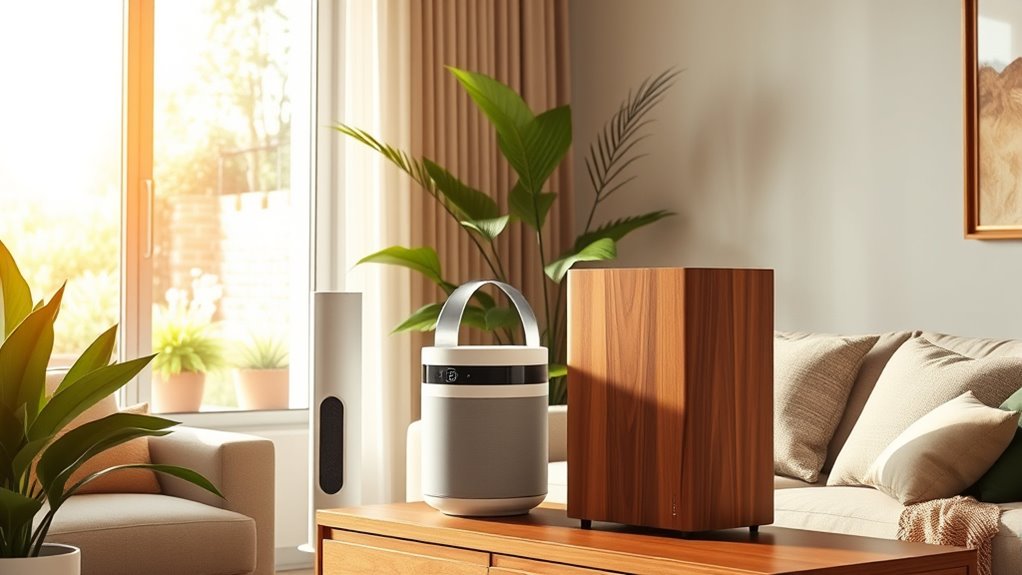
Choosing the right air purifier can feel overwhelming, especially with the variety of options available.
Selecting the perfect air purifier may seem daunting due to the extensive range of choices on the market.
Understanding the different types of air purifiers can help you make an informed choice that suits your needs:
- HEPA filters: highly effective for allergens and small particles
- Activated carbon filters: excel at removing volatile organic compounds (VOCs) and odors
- Ionizers: can produce ozone, a lung irritant
- UV-C light purifiers: target bacteria and viruses
- Clean Air Delivery Rate (CADR): confirm it matches your room size for best air quality in your home. Additionally, proper cleaning and maintenance of air purifiers is essential to ensure optimal performance and longevity.
The Role of HEPA Filters in Air Purification
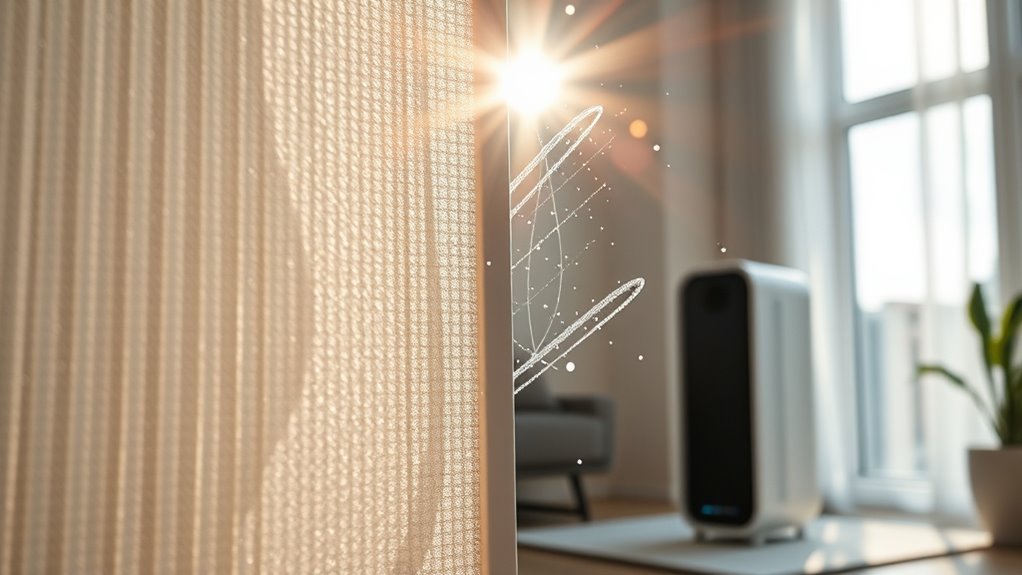
When it comes to air purification, HEPA filters play an essential role in capturing tiny particles, ensuring you breathe cleaner air.
They efficiently trap up to 99.97% of pollutants, but their effectiveness hinges on proper maintenance and timely replacements.
Understanding their efficiency and lifespan helps you maximize your air purifier’s performance.
HEPA Filter Efficiency
HEPA filters play an essential role in enhancing indoor air quality, especially for those dealing with allergies or respiratory issues. Their efficiency is critical in capturing allergens and improving your environment.
Here’s why you should care:
- They trap at least 99.97% of airborne particles, including dust and pollen.
- A high Clean Air Delivery Rate (CADR) means faster air purification.
- Regular filter replacements are essential for maintaining peak performance.
- Clogged filters can hinder air quality, worsening respiratory conditions.
- Incorporating activated carbon filters can tackle odors and gases for complete purification.
Particle Size Capture
Effective air purification hinges on the ability of filters to capture various particle sizes, and that’s where HEPA filters shine.
These filters are designed to trap at least 99.97% of particles as small as 0.3 microns, including common allergens like dust mites, pollen, and pet dander. This efficiency is essential for anyone dealing with allergies or respiratory issues, as it greatly enhances your indoor air quality.
Additionally, HEPA filters can capture even smaller particles, such as certain bacteria and viruses.
To guarantee peak performance, you should pay attention to the Clean Air Delivery Rate (CADR), which indicates how well a HEPA filter removes specific particles.
Regular maintenance and timely filter replacement are key to maintaining that high level of efficiency.
Maintenance and Lifespan
To guarantee your air purifier performs at its best, regular maintenance is essential, particularly when it comes to replacing HEPA filters.
These filters capture at least 99.97% of harmful particles, but their efficiency drops if you neglect replacement. Here’s why you should prioritize this task:
- Protect your family from allergens and pollutants
- Maintain ideal air quality in your home
- Extend the lifespan of your air purifier
- Enhance the performance of your system
- Avoid costly repairs due to inefficiency
Typically, HEPA filters last between 6 to 12 months, depending on usage and air quality.
For the best results, stick to manufacturer-approved filters to maintain efficiency and avoid voiding warranties.
Regular filter replacement keeps your air purifiers running smoothly!
Air Purifiers and Allergies: A Lifesaver for Sufferers
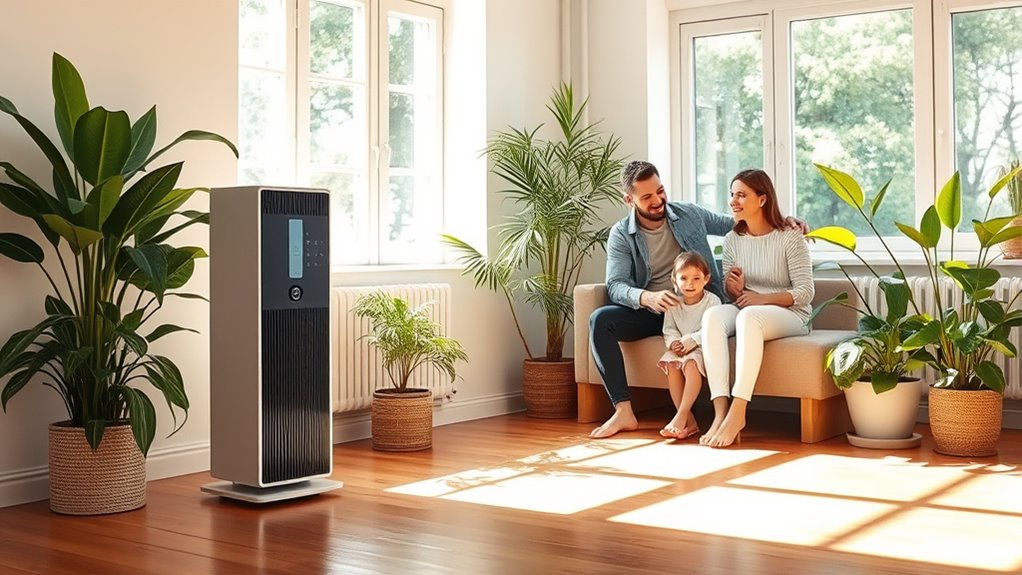
If you suffer from allergies, you know how challenging it can be to find relief, especially when allergens like pollen, mold spores, and pet dander invade your home.
Air purifiers can be a lifesaver for you by greatly improving indoor air quality. Equipped with HEPA filters, these devices capture up to 99.97% of airborne allergens as small as 0.3 microns, reducing triggers that lead to respiratory issues.
By regularly using air purifiers, you’ll notice fewer allergy symptoms and a more comfortable living environment. Plus, they help eliminate bacteria and viruses, contributing to your overall health.
Don’t let allergies control your life—invest in an air purifier and breathe easier today!
Key Features to Look for When Choosing an Air Purifier
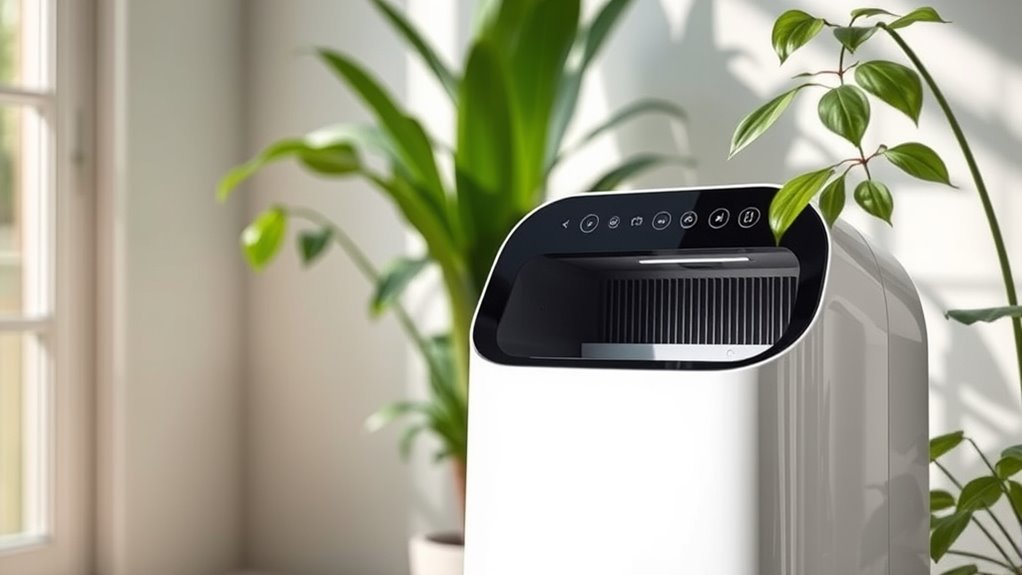
When searching for the right air purifier, it’s crucial to focus on key features that guarantee peak performance and suitability for your space.
Here are some essential aspects to take into account:
- Clean Air Delivery Rate (CADR): Confirm it’s at least two-thirds of your room’s area for effective filtration.
- HEPA Filters: Look for models that capture up to 99.97% of allergens and pollutants as small as 0.3 microns.
- Activated Carbon Filters: These effectively remove gases and odors, enhancing your indoor air quality.
- Noise Levels: Choose air purifiers with quiet operation modes for peaceful environments.
- Maintenance Schedule: Opt for user-friendly maintenance that includes easy filter replacements and reminders.
Best Air Purifiers for Every Room Size and Need
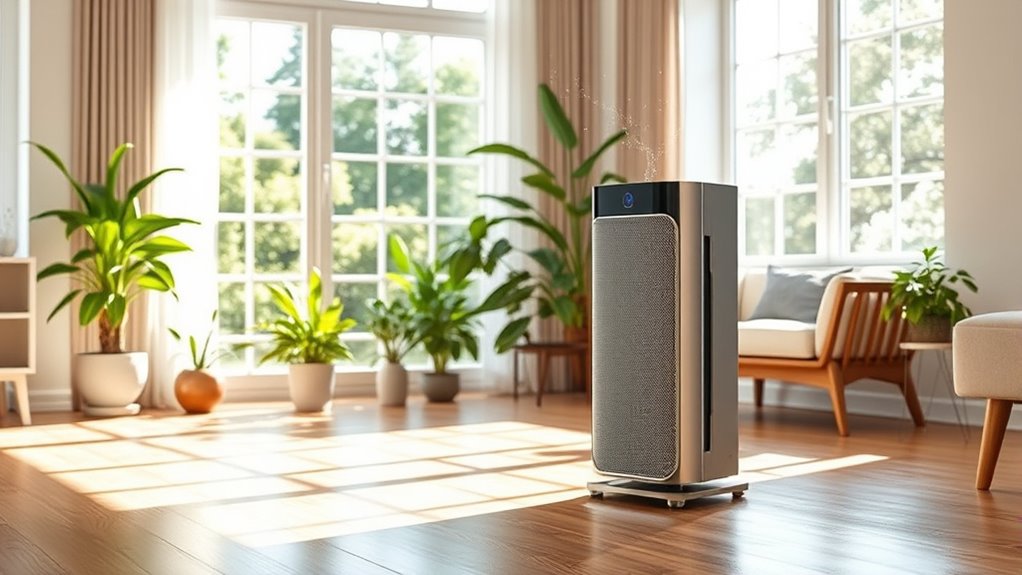
Finding the right air purifier can make a significant difference in your indoor air quality, especially since different rooms have varying needs.
For small spaces, the LEVOIT Air Purifier Core 300S is an excellent choice, effectively purifying areas up to 219 sq. ft.
If you have pets, consider the Shark HP201 & HP202, designed to tackle pet dander and odors in rooms up to 256 sq. ft.
For larger areas, the Coway Airmega AP-1512HH is among the best air purifier models, covering up to 361 sq. ft. It’s energy efficient and features HEPA Air filtration.
For extra-large rooms, the Medify MA-50 can handle an impressive 2,640 sq. ft., ensuring clean air throughout your space.
Common Misconceptions About Air Purifiers Debunked
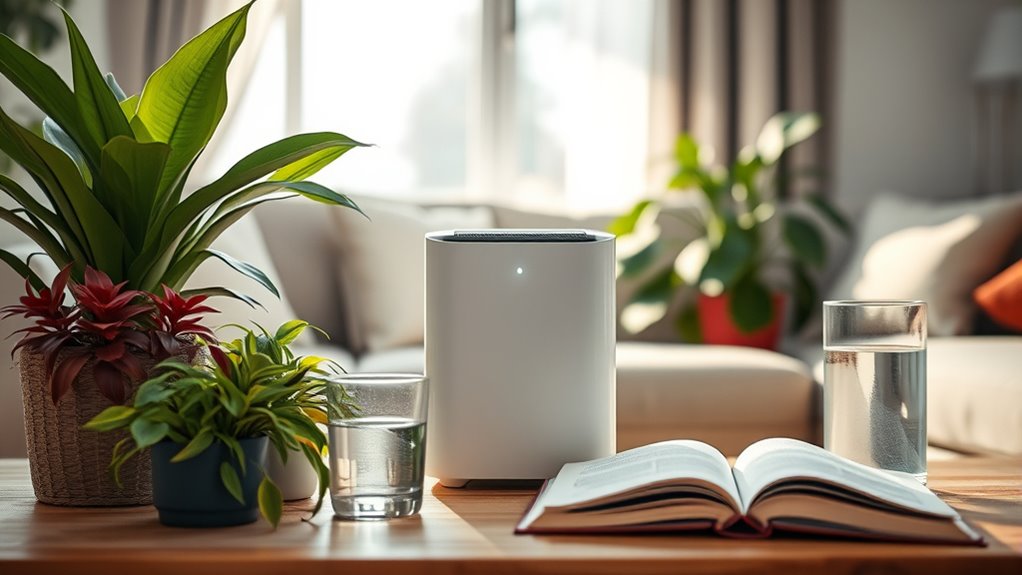
Despite the growing popularity of air purifiers, many misconceptions still cloud their true benefits and functions. Here are some common myths you might believe:
Many misconceptions about air purifiers can obscure their actual benefits and functions.
- All air purifiers are the same. They vary greatly in technology and efficiency.
- Air purifiers are expensive to operate. Modern models focus on energy efficiency, costing less to run than you think.
- They only help those with health issues. Air purifiers can help everyone by enhancing overall air quality.
- Filter maintenance isn’t important. Regular maintenance is essential for peak performance and clean air.
- They eliminate all indoor pollutants. Unfortunately, they can’t remove settled particles or gases like carbon dioxide.
Understanding these facts can help you make informed decisions about your air quality and overall health.
Maintenance Tips for Optimal Air Purifier Performance
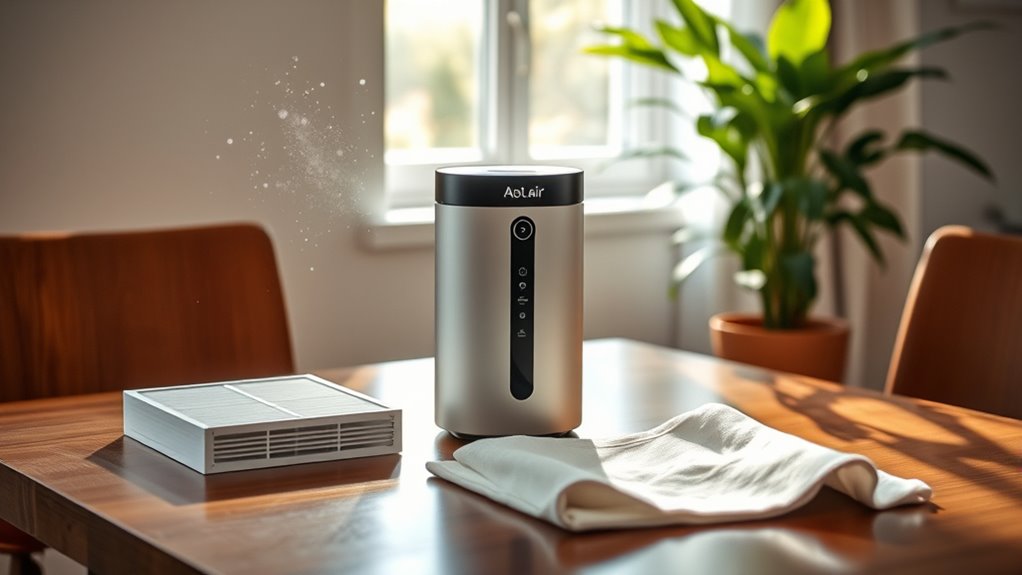
To guarantee your air purifier operates at its best, regular maintenance is essential.
Start by replacing HEPA filters and activated carbon filters every 6 to 12 months, as recommended by the manufacturer, to sustain ideal air quality.
Clean pre-filters or wash reusable filters monthly to maximize airflow and efficiency, preventing dust accumulation that can hinder performance.
Verify your air purifier is the right size for your room to achieve proper air changes per hour.
Additionally, periodically check and clean the unit’s exterior and fan to maintain effective air circulation.
If your purifier has air quality indicators, monitor them to know when it’s time for a filter replacement, confirming your unit remains effective and efficient.
Frequently Asked Questions
What Are the Dark Side of Air Purifiers?
When you consider the dark side of air purifiers, it’s essential to note that some models can produce ozone, which irritates your lungs and worsens respiratory issues.
Budget-friendly options may not effectively capture allergens, giving you a false sense of security.
Additionally, many purifiers fail to address harmful volatile organic compounds or settled dust, leaving your indoor air quality compromised.
Always research thoroughly before choosing an air purifier to guarantee it meets your needs.
What to Know Before Buying an Air Purifier?
Before buying an air purifier, consider its Clean Air Delivery Rate (CADR) to guarantee effective filtration for your room size.
Look for true HEPA filters that capture 99.97% of tiny particles, including allergens.
Pay attention to noise levels, especially for bedrooms, and check maintenance needs like filter replacements.
Finally, evaluate the purifier’s size and coverage to match your space, as larger areas may need more powerful units for ideal performance.
Is There Anything Bad About Air Purifiers?
Yes, there can be downsides to air purifiers.
Some models produce ozone, which can irritate your lungs and worsen respiratory issues. Not all units are effective; those without HEPA filters mightn’t reduce pollutants well.
You’ll also need to replace filters regularly, which can be costly. Plus, their effectiveness is limited to the room they’re in, and they won’t eliminate settled dust or VOCs.
Be mindful of these factors when choosing one.
What Is the Most Highly Recommended Air Purifier?
They say, “The best things in life are often the simplest.”
When it comes to air purifiers, the Coway Airmega AP-1512HH Mighty often tops the list for its excellent performance and compact design.
It efficiently covers spaces up to 361 sq. ft. and removes over 99% of smoke in just 30 minutes.
If you’re looking for a reliable choice, this model’s user ratings and effectiveness make it hard to beat.
Conclusion
To sum up, investing in an air purifier is like giving your home a revitalizing change. With the right knowledge about air quality and the various types of purifiers available, you can make an informed choice that suits your needs. Whether you’re battling allergies or just want cleaner air, these devices can make a significant difference. So, take the plunge and enhance your indoor environment—you and your health will thank yourself later!
